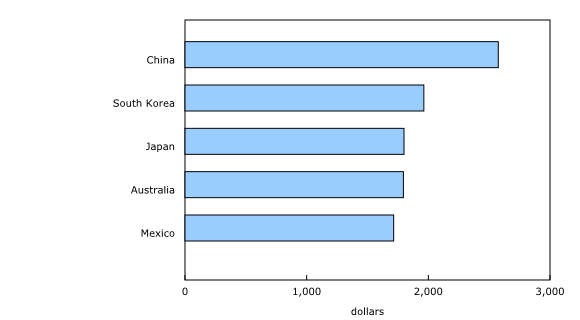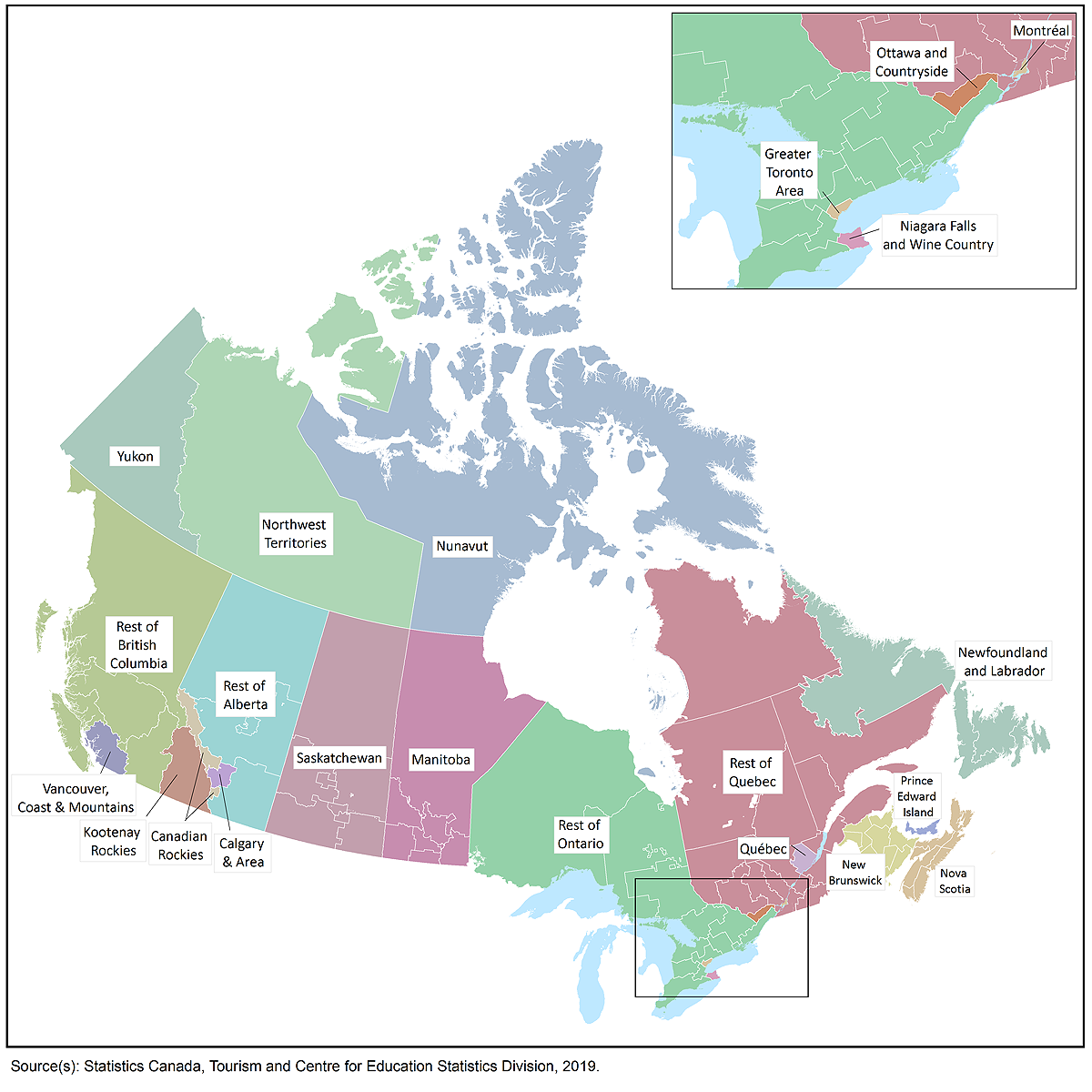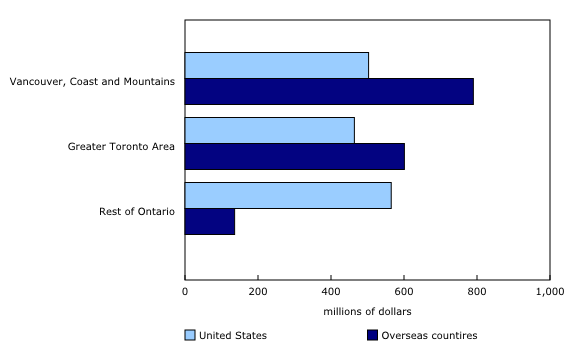Visitor Travel Survey, second quarter 2019
Archived Content
Information identified as archived is provided for reference, research or recordkeeping purposes. It is not subject to the Government of Canada Web Standards and has not been altered or updated since it was archived. Please "contact us" to request a format other than those available.
Released: 2019-11-27
Highlights
Canada welcomed 8.8 million international travellers in the second quarter, just over three-quarters (76.8%) of whom came from the United States. Spending in Canada by foreign travellers totalled $6.3 billion, up from $5.8 billion during the second quarter in 2018. The growth was led by increased spending by US travellers (+10.7%) in Canada.
Holidays, leisure or recreation is the most common trip purpose for US travellers to Canada
US residents made 6.7 million trips to Canada in the second quarter, up 4.7% from the same quarter a year earlier.
Holidays, leisure or recreation was the most common reason for travel to Canada (3.0 million trips) in the second quarter, accounting for 44.0% of all trips from the United States. Travel to Canada to visit friends and family (1.3 million trips, or 19.5%) was the second most common reason.
US residents spent $3.3 billion while travelling in Canada, up from $2.8 billion during the second quarter of 2018. The average expenditure was $486 per trip. Accommodation (39.5%) and food and beverages (25.9%) were the largest expense items, followed by costs of transportation within Canada (17.1%) and recreation and entertainment (9.4%).
Ontario was the province most visited by US residents, with 3.4 million visits. This represented 44.8% of all visits to provinces by US residents during the quarter.
Overseas residents come to Canada primarily to visit friends and relatives
Travellers from overseas (countries other than the United States) made 2.0 million trips to Canada in the second quarter.
Visiting friends and family was the most common travel purpose for overseas travellers to Canada in the second quarter, accounting for 40.8% of all trips from overseas. Pleasure and leisure was the next most common reason for visiting Canada, accounting for one-third of all trips from overseas.
At 989,000 visits, Ontario was the most visited province by overseas travellers during the quarter, followed by British Columbia (740,000 visits).
Travellers from overseas countries spent $3.1 billion while travelling in Canada during the second quarter, up from $3.0 billion during the second quarter of 2018. These overseas travellers spent an average of $1,498 per trip. However, average tourism spending in Canada varied greatly depending on the country of residence of the travellers. For example, among the major source countries of visitors to Canada, visitors from China spent an average of $2,575 per trip, while visitors from India spent $807.
Regarding the length of stay during trips to Canada, residents of overseas countries stayed an average of 19 nights per trip, compared with an average of 5 nights for travellers from the United States.
Accommodation (34.4%) and food and beverages (25.3%) were the largest expense items for overseas residents. Other significant expense items were clothes and gifts (16.7%), transportation within Canada (11.2%) and recreation and entertainment (9.5%).
Travellers from abroad spend the most in Ontario
Travellers from abroad spent $2.3 billion in Ontario, up from $1.9 billion in the second quarter of 2018. Foreign travel spending in Ontario in the second quarter represented 36.1% of the national total and was the highest amount for any province.
The Greater Toronto Area—the top-earning tourist region in Ontario, and the second highest-earning region nationally, following the Vancouver, Coast and Mountains region—accounted for nearly half ($1.1 billion) of total foreign travel spending in Ontario. Overseas travellers spent $601 million in the region, while U.S. visitors spent $464 million. Visitors from China ($124 million) and the United Kingdom ($61 million) spent the most among overseas travellers.
British Columbia accounted for the second largest share of foreign travel spending, at $1.8 billion (29.1% of the national total), up 4.4% from the same quarter of 2018.
At $1.3 billion, or 20.4% of the national total, the Vancouver, Coast and Mountains region was the region that earned the most from foreign travellers. Overseas travellers spent $790 million in the region, accounting for 61.1% of the total foreign spending in the region, while US visitors spent $503 million. Visitors from China ($176 million) and Mexico ($112 million) spent the largest amounts in the region among overseas visitors.
The tourism region comprising Ontario outside of Toronto, Niagara Falls, Ottawa and their surrounding areas, ranked third in tourism spending among Canadian tourism regions, at $701 million. This region earned the most from US travellers (80.6%, or $565 million).
Note to readers
The Visitor Travel Survey (VTS) collects information about international travel to Canada by US and overseas residents.
The VTS was developed to fully replace the inbound visitor component of the International Travel Survey (ITS) and consists of two components: electronic questionnaires and the Air Exit Survey. Data from the VTS are historically comparable with data from the ITS.
The VTS uses Statistics Canada's Frontier Counts as benchmarks for the numbers of travellers to Canada. Statistics Canada's Frontier Counts are produced using administrative data from the Canada Border Services Agency (CBSA) on all international travellers who have been cleared for entry or re-entry into Canada.
In 2018, Statistics Canada undertook a review of sources of data on overseas residents entering Canada at land ports. Overseas residents who enter Canada at land ports represent about 10% of total overseas travellers to Canada. Total counts of overseas travellers were revised to reflect new sources of data at some ports. In addition, starting with August 2018 Frontier Counts data, Statistics Canada implemented a new method for estimating the country of residence through breakdowns of these overseas travellers when they enter Canada at most land ports. These changes affect the total counts of travellers to Canada from individual countries to varying degrees.
Starting with the release of 2018 data, VTS data include subprovincial estimates of tourism spending by international visitors to Canada. These estimates are produced using small area estimation (SAE) modelling to combine data collected from the VTS with aggregated payment processor data acquired by Destination Canada and provided to Statistics Canada. Data from the payment processor include information on spending category, tourism region and country of origin for credit cards used by international visitors to Canada. Methodological information is available in the document Small Area Estimation for Visitor Travel Survey.
The sum of spending data derived from the SAE model will not equal the sum produced by the VTS alone. When analyzing spending data, it is recommended to use the estimates derived from the SAE model.
Overseas countries refer to countries other than the United States.
A trip to Canada is made by a resident of a country other than Canada who is cleared through a CBSA point of entry on a visit for a period of less than 12 months. A Canadian citizen residing outside Canada for more than 12 months who comes to Canada is included as a traveller from a country other than Canada.
A trip to Canada for a person residing in a country other than Canada starts when they are cleared through a CBSA point of entry to enter Canada and ends when they exit Canada.
Trips and visits: A trip can consist of one or more visits. A traveller from a country other than Canada may stay in several locations during a trip to Canada. Each stay at a Canadian location (for example, a province) within a given trip represents a visit.
Products
The Visitor Travel Survey (VTS) collects information about international travel to Canada by US and overseas residents.
The VTS was developed to fully replace the inbound visitor component of the International Travel Survey (ITS) and consists of two components: electronic questionnaires and the Air Exit Survey. Data from the VTS are historically comparable with data from the ITS.
Contact information
For more information, or to enquire about the concepts, methods or data quality of this release, contact us (toll-free 1-800-263-1136; 514-283-8300; STATCAN.infostats-infostats.STATCAN@canada.ca) or Media Relations (613-951-4636; STATCAN.mediahotline-ligneinfomedias.STATCAN@canada.ca).
- Date modified:




